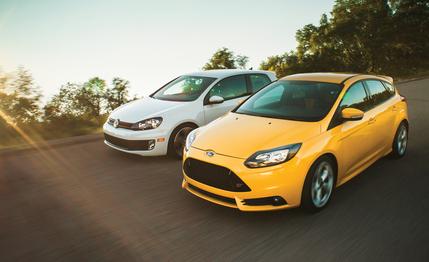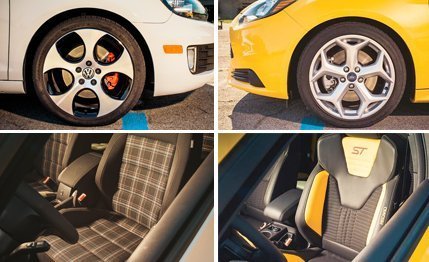
 Comparison Tests
Comparison Tests




Loneliness is never a worry when you’re at the top of the hyperkinetic-hatchback class. Every few months, some punk with fat tires and delusional aspirations shows up to pick a fight. But since 2009—when the sixth-generation VW GTI arrived—this paragon of German engineering has not been caught by that succession of hostile pursuers. Over its long run, the GTI has evolved into the slot-car cynosure—the very definition of affordable fun and function—worthy of four straight berths on our 10Best list.


Even though this is the final model year for the sixth-gen GTI, it’s game for another go. The $24,790 three-door in this comparison is the lightest, most affordable example of a lovable breed. It’s powered by a small, turbocharged, direct-injected engine, a combination pioneered by Audi in 2005 that’s quickly becoming S.O.P. While a cast-iron cylinder block with power capped at an even 200 horses is slightly behind the curve, the GTI’s 2.0-liter four working through six nicely spaced gear ratios pleases without a ruckus. The standard-equipment list includes high-bolster cloth-upholstered buckets, a grippy leather steering wheel, a dead pedal to die for, handsome 18-inch wheels, and tasteful red interior and exterior accents.


Ford’s Special Vehicle Team (SVT) turns 20 in 2013. To celebrate, a hot Focus—on hiatus since 2004—rejoins the fold. But this one is tuned by SVT’s European allies, hence the ST (Sport Technologies) nameplate. Knowing precisely what’s required to run with the GTI, Ford’s German Team RS engineers—the group that developed the car—put the Focus on a grueling training regimen. A BorgWarner turbo supplies 19.5 psi of boost with an extra 20 seconds of overboost (up to 21 psi) to wring an impressive 252 horsepower out of the 2.0-liter aluminum-block four-cylinder engine. Its 270 pound-feet of peak torque mercilessly wallops the GTI’s 207 pound-feet maximum twist. Meaty Goodyear Eagle F1 Asymmetric 2 radials give the Focus the traction edge, while the springs, dampers, anti-roll bars, and front and rear suspension uprights are all specifically engineered for this car. And instead of limiting the inevitable front-tire slip by reining in the powertrain, the RS crew programmed the electrically assisted variable-ratio rack-and-pinion gear and the front brakes to counter torque steer and wheelspin. Outside, a double-slot roof extension, centered exhaust outlets, and lower body skirts signal the ST’s malevolent intent. Inside, the leather-wrapped steering wheel wears the ST badge and there’s an added row of gauges atop the dash to display boost, oil pressure, and oil temperature. Recaro seats (in either partial or full leather) are part of two expensive option packages.


Unlike the GTI—a sprawling family of cars offered in three- or five-door body styles, with or without a dual-clutch automatic—the Focus ST comes only as a five-door with a six-speed manual transmission. Our visually assertive tester, which starts with a base price of $24,495, cost $28,170 with the addition of Tangerine Scream tri-coat paint ($495), navigation ($795), and a $2385 package consisting of the partial-leather Recaros, dual-zone climate control, HD radio, Sirius satellite reception, a 10-speaker Sony audio system, and MyFord Touch with an eight-inch LCD screen.